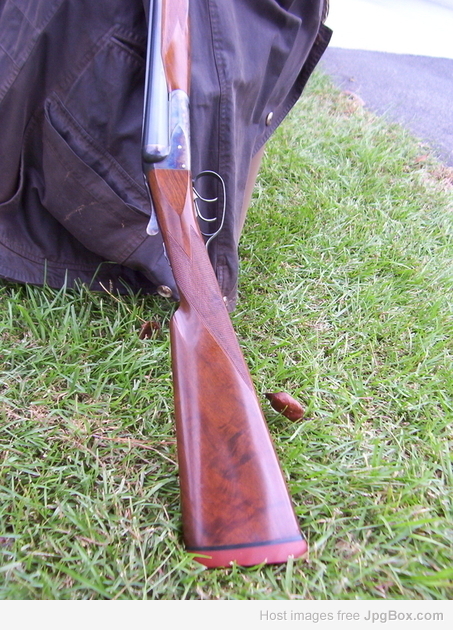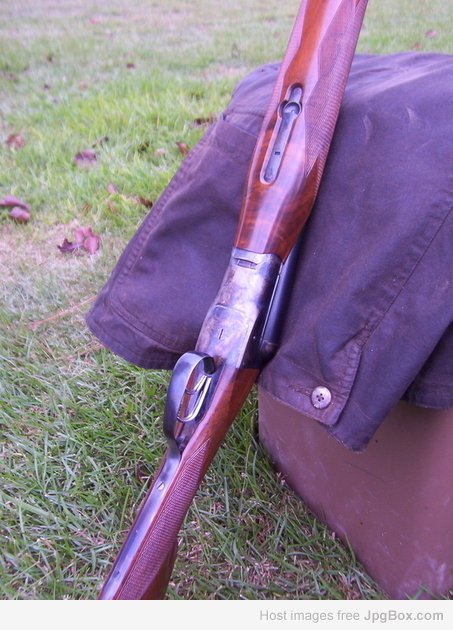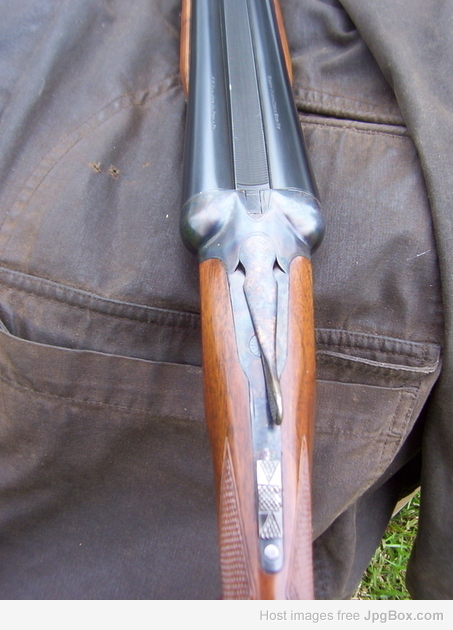
 |
| ||||||||||||||||||||||||||||||||||||||||||
|
|
#3 | ||||||
|
I like the damascus finish even if it is a little pale.
|
||||||
|
|

|
||||||
|
|
#4 | ||||||
|
And the sad part is that far too many have no clue what is proper and improper work. Period.
__________________
B. Dudley |
||||||
|
|

|
||||||
| The Following 8 Users Say Thank You to Brian Dudley For Your Post: |
|
|
#5 | |||||||
|
Quote:
.
__________________
"I'm a Setter man. Not because I think they're better than the other breeds, but because I'm a romantic - stuck on tradition - and to me, a Setter just "belongs" in the grouse picture." George King, "That's Ruff", 2010 - a timeless classic. |
|||||||
|
|

|
|||||||
| The Following User Says Thank You to Dean Romig For Your Post: |
|
|
#6 | ||||||
|
Salient points, Bruce. Concerning the wood to metal fit ..........
I have been considering a project to convert a restocked A grade Philly Fox from a semi-beavertail to a long splinter. Doing due diligence to determine if the wood is currently fitted closely enough to the underside and sides of the barrels, so as to not have unsightly gaps when the excess wood is cut away, I have been measuring how well the upper edges of the f/e wood is fitted to the barrels on many of my splinter f/e vintage guns. I have yet to find one that is fitted snugly along these edges, including my high condition DHE Parker. My graded Foxes have a uniform space from front to within about an inch of the f/e iron that will accept .025" - .030" shim all that way. Make no mistake, these forends are tight to the gun, with no looseness, but the upper edges are not contacting the barrels. If any of you have your better grades of American classics out any time soon, and can spare a moment to check that fit for me, would you please? I would be very appreciative. Brian, could you shed any light on this from a gunstocker's point of view? Last edited by Stan Hillis; 10-16-2021 at 08:36 AM.. Reason: dang spellcheck |
||||||
|
|

|
||||||
|
|
#7 | ||||||
|
Stan, I would consider that wood shrinkage over 100 or so years might account for much of the gap. The forend fit to the barrels is not critical like it needs to be at the stock head to frame. And the shrinkage in the lenght of the grain is rarely what it is across the grain.
.
__________________
"I'm a Setter man. Not because I think they're better than the other breeds, but because I'm a romantic - stuck on tradition - and to me, a Setter just "belongs" in the grouse picture." George King, "That's Ruff", 2010 - a timeless classic. |
||||||
|
|

|
||||||
| The Following 2 Users Say Thank You to Dean Romig For Your Post: |
|
|
#8 | |||||||
|
Quote:
I would not place any bets on a beavertail being able to be successfully converted to a properly fitted splinter at all. The chances are very slim and there is no way of knowing until you cut it up and see what it looks like. There are so many contact points and if any one spot is off, it is no good. That is if you want it the way it should be. A beavertail does not need 100% contact on the barrels, neither does a splinter for that matter. Just in the areas that you see. Even when you look at factory guns with use, the bluing will wear along the edges where the wood contacts, and maybe a few other areas, but that is all. Not that the other surfaces are not a close fit, they just are not full contact. With a beavertail the amount of fitting work is significantly greater than a splinter, I personally charge twice the price to make a beavertail as I do a splinter. At least for a Parker, because there is a draw-bolt also involved. But anyway… It many cases, a splinter is usually more tightly fitted than a beavertail, especially a full beavertail that really comes up around the sides of the barrels. To summarize. Cut the sides off your fox forend and see what you are dealing with, but you should really be budgeting on just having a new forend made in the end.
__________________
B. Dudley |
|||||||
|
|

|
|||||||
| The Following 4 Users Say Thank You to Brian Dudley For Your Post: |
|
|
#9 | ||||||
|
Thank you Brian, very much. I have been given that advice from a couple other friends on another board. The "evidence" is piling up. If a professional gun stocker cannot tell beforehand if an existing btfe could be successfully converted to splinter, I certainly doubt my abilities to.
My desire to have a splinter on the gun in question is strictly aesthetical. It is a pretty restock, well done, and is not a huge beavertail. But, the gun is a 32" barreled A grade that just screams out for a long, ebony tipped forend, IMO. It's just something I "want". It seems that a new forend may be the way to go. I just have my doubts at being able to match wood grain and color with a new piece of wood. What degree of contact do you try to achieve, along those upper edges, when doing a restock on a splinter f/e? Here's the gun in question:    Thanks again for the help, and apologies Bruce, if I'm causing the thread to stray too much. |
||||||
|
|

|
||||||
| The Following 3 Users Say Thank You to Stan Hillis For Your Post: |
|
|
#10 | ||||||
|
Matching wood figure and color for that would not be difficult at all if one has a selection to choose from.
__________________
B. Dudley |
||||||
|
|

|
||||||
| The Following 3 Users Say Thank You to Brian Dudley For Your Post: |
 |
|
|